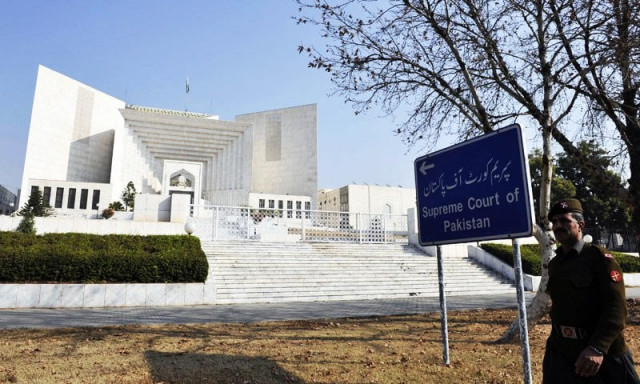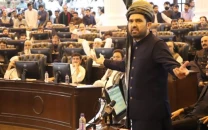A ‘rainbow’ Supreme Court emerges
Apex court issues various landmark verdicts including one clipping PM’s powers

In August 2015, the top court’s 17-judge bench issued a landmark judgment, wherein establishment of military courts through the 21st constitutional amendment was validated. The historic ruling, which has been referred to internationally, contains varying views on the issue.
However, in 2016 the judges continued to show this diversity of views in several matters.
A five-judge bench, headed by outgoing Chief Justice Anwar Zaheer Jamali on January 22, 2016 allowed the hunting of vulnerable migratory bird houbara bustard commonly known as tiloor as it set aside a judgment, passed by a three-judge bench headed by chief justice Jawwad S Khawaja on August 19, 2015.
Unsatisfactory work: Supreme Court seeks replies on functioning of NSUSC
However, one member of the bench Justice Qazi Faez Isa opposed the majority opinion and raised serious questions in his 14-page dissenting note. Similarly, the judges sitting in different other benches expressed their respective views, which were sometimes conflicting.
The Pakistan Bar Council former vice chairman Azam Nazeer Tarar believes that it is healthy trend that the superior court judges are using their independent mind, adding that the superior judiciary is not a disciplined force, wherein everyone follows the same rule.
Tarar, however, adds that there is a little difference between harmony and independence as both are important for strengthening the institution.
“I think harmony among judges was lacking in 2016 but I expect that new chief justice Mian Saqib Nisar will provide the environment of harmony and independence to the SC judges,” he says.
Civil service structure
In 2016, the top court continued its efforts to streamline the civil service structure of the country.
In May 2013, the apex court issued a comprehensive judgment, declaring all out-of-turn promotions, deputations, absorption and reappointments illegal in Sindh. The judgment was authored by Justice Amir Hani Muslim.
In 2016, the bench led by Justice Hani initiated proceedings on compliance of its verdict in the federal capital and other provinces. In July, 2016, the Punjab police told the SC that it had withdrawn 10,884 out-of-turn promotions.
The court also took notice of the alleged illegal appointments in the National Accountability Bureau (NAB) and sought complete record and profile of bureau officers of grade-18 and above.
The court also restrained all four chief ministers from appointing assistant commissioners (ACs) on quota system. The matter was also referred to the chief justice for examining whether the CM’s power under West Pakistan Civil Service Rule 1964 is voilative of the Constitution or not.
A quiet revolution
Justice Asif Saeed Khosa has brought a quiet revolution in the apex court as he is heading a special bench that has decided around 7,000 criminal appeals during the last two years. Merely 900 criminal appeals are pending. A senior official told The Express Tribune that there will be zero pendency of criminal cases till May of this year. On the other hand, pendency of civil cases has risen in past year and around 30,000 cases of civil nature are pending.
Election tribunal vested with suo motu powers, says Supreme Court
The acquittal rate of convicts especially death row prisoner has also risen in the top court last year. The members of the legal fraternity ascribed the high acquittal rate to the application of the principle of ‘Falsus in uno, falsus in omnibus’ (False in one thing, false in everything). The wrongful executions of the two brothers in a southern Punjab district also exposed serious flaws in Pakistan’s criminal justice system last year.
Landmark judgments
Last year, the top court also gave landmark judgments, which have serious implications. These verdicts have also been vigorously highlighted in the media.
The top court on August 18, 2016 defined the power of ‘federal cabinet’ and ruled that the prime minister cannot act unilaterally on the country’s financial issues or approve any ordinance without first gaining the federal cabinet’s approval, citing constitutional strictures.
Meanwhile, the top court also declared appointments of the Islamabad High Court’s officials as illegal. The verdict has also profound repercussions on the superior judiciary. One top court’s judge Justice Iqbal Hameed ur Rehman tendered resignation after that verdict.
The Panamagate case has also dominated the apex court. In May, the outgoing CJP refused to accept the federal government’s request to form a commission on its terms of reference (ToRs). Later, the PTI approached the apex court seeking disqualification of the PM. The top court’s larger bench conducted 10 hearings but the decision could not be issued due to the retirement of the CJP Jamali.
Last month, the SC’s Justice Isa also issued a worth reading inquiry report on August 8 Quetta blast, in which a numbers of lawyers were killed. The matter is still pending in the apex court.
Published in The Express Tribune, January 1st, 2017.


















COMMENTS
Comments are moderated and generally will be posted if they are on-topic and not abusive.
For more information, please see our Comments FAQ